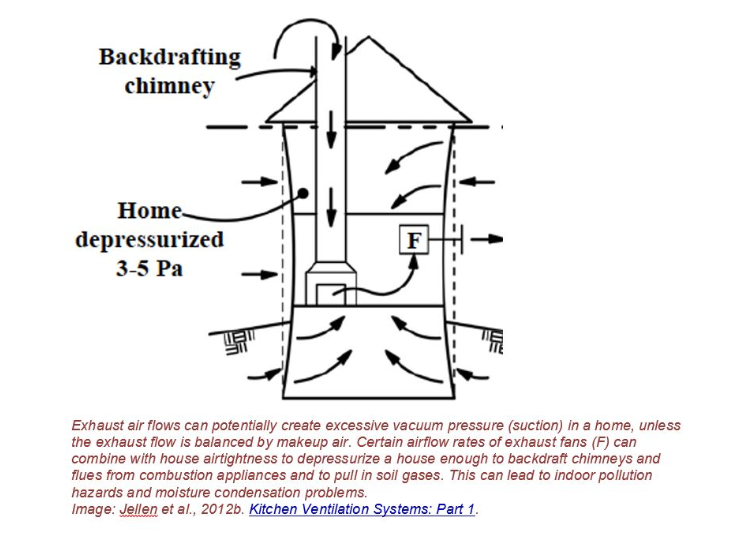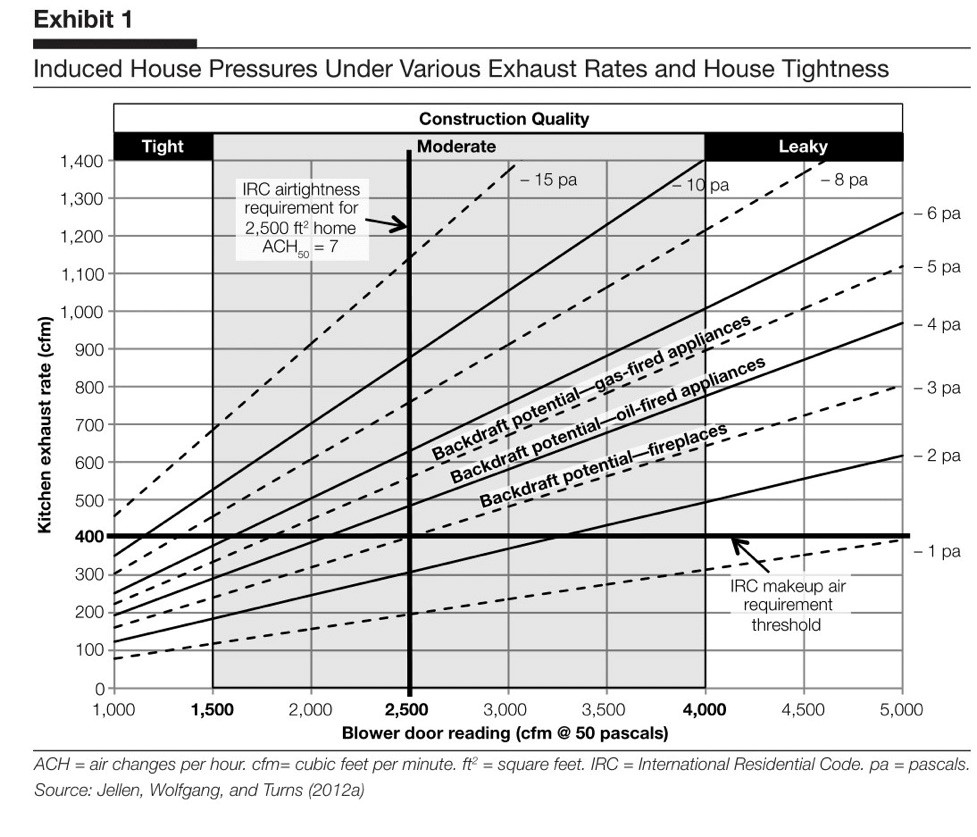SUPPLEMENT 3: Caveats and Cautions
December 2019
PREVENT EXCESS DEPRESSURIZATION
Hoods with higher maximum airflow rates (over 300-400 cfm) can often cause imbalances in airflows in and out of the home. Professional style gas stoves with large burners and downdraft exhaust systems typically require high airflow rates. When insufficient air is brought into the home to balance exhaust flows from exhaust fans and other appliances, depressurization (negative air pressure, or suction) of the home occurs. This can cause combustion equipment to backdraft carbon monoxide and other combustion pollutants into the home. It can also pull unwanted pollutants from adjoining spaces and the outdoors. If naturally vented combustion appliances are present, a combustion appliance safety test is recommended in such situations; this test is required in most home weatherization programs.(1)

Make-up air devices are available to prevent depressurization problems; some can be integrated with central air or ventilation systems. The International Mechanical Code used in some regions requires make-up air if the fan has a rating of 400 cubic feet per minute (cfm) or more when natural draft combustion appliances are present. It also requires make-up air for hood flows of 300 cfm or more in alterations of some types of older homes, exhaust flow calculations for multiple appliances, and a backdraft and spillage test in newer homes.(2) However, both natural draft and induced draft appliances can easily backdraft, so the more efficient direct-vent (sealed combustion) appliances are recommended to minimize such problems.(3)
Downdraft stovetop exhaust systems are an example of fans with very high flow rates. They often produce flows of over 500 cfm in order to effectively overcome the hot, buoyant plume generated by cooking. Commercial style stoves and ovens also require very high flow rates, in order to remove the large amount of heat produced. High flow hood systems that are used frequently can also substantially increase building energy use for meeting cooling, heating, or dehumidification needs.
For airtight homes and homes with high flow exhaust hoods, test the pressure difference between indoors and outdoors when the range hood is on. The graph below (Exhibit 1) illustrates how much house depressurization could be anticipated from various sizes of kitchen exhaust fans at different levels of home airtightness. The hood airflow rate of 400 cfm is also highlighted; the International Residential Code (IRC) requires make-up air above that airflow rate. A tight home is defined there as one with a blower test rating of 1,500 cfm or less at 50 Pascals pressure (CFM50).
For example, the diagonal lines in Exhibit 1 indicates that a fireplace in a tight home (1,500 CFM50 or less) would potentially start backdrafting at a hood flow rate of 250 cfm or less, whereas a gas-fired appliance (natural draft) would potentially start backdrafting at a hood flow rate of 350 cfm or less, even though they are both below the IRC makeup air threshold of 400 cfm. Local weather conditions can also affect house pressures. Note that many homes have blower door ratings of less than 1,000 CFM50 and would backdraft at much lower airflow rates for the hood.

Consult building officials and building performance experts to determine what local depressurization limits are and how to best meet them. These limits range from -2 to -50 Pascals, depending on the type of combustion appliance, airtightness, and regional climate.(4)
In order to provide reliable operation, gravimetric or barometric dampers are not allowed for use in make-up air systems, according to ASHRAE 62.2-2016. Rather, an automatic (interlocked) motorized damper or a fan-powered system is required.(5) In addition, make-up air systems should have an air filter to help keep outdoor air pollution, allergens, and dust from entering the home. Test the installed makeup air system to verify safe depressurization levels and proper damper operation and air flow, as shown by Guertin.(6)
Make-up air systems can also cause thermal comfort problems (cold drafts) and humidity problems. In order to avoid cold drafts from make-up air, some designers recommend supplying 70% of the make-up under the stove and 30% to a common area, in order to create negative pressure near the stove and minimize draft problems.[7] A designer of very airtight homes (near Passive House criteria) in California has successfully used ducted range hoods with make-up air with little impact on energy use or comfort.(8)
Research continues on how to best integrate kitchen and whole house ventilation. European researchers have recently recommended that low energy, airtight homes use either 1) a motorless range hood, with a high quality grease filter, that can be connected to a common exhaust system using a balanced ventilation system for the house, or 2) a ducted exhaust vent used with a supply ventilation system at specific design pressures (9); further studies are underway. A small field study found that heat or energy recovery ventilators did not effectively remove particle emissions from cooking in low energy single-family homes, even when using the boost function.(10) Also, range hoods with automatic sensors are under development.(11) These are evolving areas of healthy building design, so proceed with caution.
PREVENT CARBON MONOXIDE (CO) POISONING
Never heat the house with a gas stove or oven. This can be fatal or cause permanent damage to your health. It can also increase the risk of pneumonia in young children.(12)
Have a technician check the gas pressure and burner adjustments, especially in propane stoves or if the flame is mostly yellow, erratic, or causing sooting on pots and pans.(13) Gas stoves and ovens often produce excessive amounts of CO, but regular testing and maintenance can greatly reduce this hazard.(14)
Do not cover the bottom of natural gas or propane ovens with aluminum foil. Doing so blocks the combustion airflow through the appliance and can increase CO emissions.
If you are cooking on several burners or over extended periods and do not have a working range hood, open some windows to create a cross draft to remove the indoor pollutants, or use a kitchen exhaust fan.
Install a CO alarm if you have a gas stove or oven or other natural draft (non-direct vent) gas appliances in the home. This is required in many jurisdictions.
1 (BPI 2012; US EPA 2014)
2 (IMC 2018)
3 (Minnesota 2015; Bohac & Cheple 2002)
4 (Nelson 2010; BPI 2012; Jellen et al. 2012a)
5 (Karg 2016)
6 (Guertin 2017)
7 (Lstiburek 2014)
8 (Barry 2017)
9 (Jacobs & Borsboom 2017)
10 (Militello-Hourigan and Miller 2018)
11 (DOE 2019; Walker, 2019)
12 (Coker et al. 2015)
13 (Appliance411 2018)
14 (Birkby 2008)
